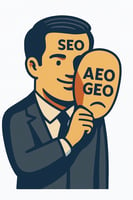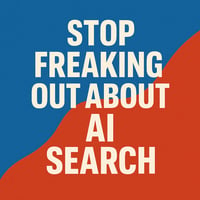Every few years, a new wave of technology sparks doomsday predictions about the “death of SEO.”...
SEO and Advertising Fueled the Rise of AI
How marketers and Google trained the system that AI is now replacing
Let’s be honest, marketers and Google built the machine that AI is now dismantling.
For years, we optimized, gamed, and over-engineered every corner of the internet for clicks, conversions, and crawlability. We trained entire teams to write for algorithms instead of humans. We built funnels instead of conversations and keyword maps instead of meaningful content.
So when AI showed up promising faster, cleaner, no-nonsense answers, it wasn’t the villain. It was the inevitable evolution of a system that forgot who it was serving. We can’t get upset about the mess we made.
- Clickbait.
- Pop-ups.
- Walls of text stretched for SEO metrics rather than reader value.
What started as “optimization” became a race to the bottom. Content ballooned from quick insights to padded essays where the actual answer doesn’t appear until the third paragraph or later. Readers stopped reading. They started scanning.
The Problem: We Broke the Internet Experience
People don’t want to slog through ads, autoplay videos, and “ultimate guides” just to find one simple fact. But that’s exactly what the ad economy incentivized. Writers wrote for bots. Publishers chased ad impressions. Audiences became an afterthought.
It wasn’t malicious. It was mechanical. The business model rewarded pageviews, not people. The longer someone stayed, the more the ads paid. But the longer the content dragged, the faster trust eroded.
We made for a bad user experience and then acted surprised when users started leaving.
AI was likely inevitable, but we made it easy for it to take over. Today, roughly 60% of Google searches end without a click (SparkToro, 2024). Users are tired of digging through digital junk drawers. They want answers, not articles. And AI gives them exactly that.
The Shift: AI Gives Without Trying to Get
Then AI arrived.
Traditional content demanded your attention before offering value. AI flipped the equation. It gives first. Ask a question, get an answer. No scrolling. No noise. No twenty-paragraph intro about “the history of productivity hacks.”
AI doesn’t need to trick you into engagement. It doesn’t care about ad revenue or bounce rate. It just delivers. That’s why users embraced it instantly. It feels like genuine customer service in a digital world that forgot how to serve.
The Takeaway
For all the fear about “AI replacing marketers,” maybe it’s just cleaning up after us. SEO, content marketing, and ad tech made the web bloated, noisy, and transactional. AI made it useful again.
We trained audiences to value answers, not journeys. AI just listened.
So before we blame the bots, maybe we should admit: we optimized ourselves out of relevance.
For a look at how SEO itself is adapting to this new reality, read SEO Isn’t Dead – It’s Evolving for AI (AEO + GEO).
What Comes Next
But here’s the real question: will AI search repeat the cycle?
Check out Stop Freaking Out About AI Search – We’ve Been Here Before for more context on how every major search shift has followed this same pattern.
Will it follow the same path, starting pure, fast, and user-focused, only to slowly get monetized, over-optimized, and bloated in the name of growth?
Will the quest to monetize AI spoil the simplicity that made it great in the first place?
Time will tell.
History suggests that every breakthrough eventually bends to economics. If that happens again, we’ll be back where we started, searching through the noise we created.
Joshua Banks
Digital Marketing Leader & Strategist
About JRIVEN:
JRIVEN is a mission-driven marketing consultancy led by Joshua Banks, helping brands bridge strategy, storytelling, and performance through intelligent marketing systems and honest communication.



